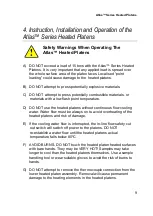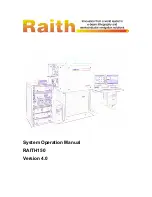
Atlas™ Series Heated Platens
21
Note:
It is
very important
that the appropriate voltage of operation for
the top (
1
) and lower (
2
) heated platen assemblies (either 240
volts or 110 volts) are connected to a controller of the same
mains voltage output for operation. Ensure that the serial
number found on the appliance label (
16
) at the rear of the
controller matches the serial number stickers found on the top
and lower heated platen assemblies to be connected. There is
an indication of the voltage of operation on the heated platen
assemblies too.
The K-type thermocouple lead fitted into the lower heated platen (
2
)
assembly only is also connected to the rear of the controller via a 2 pin
plug connection socket (
17
). Ensure that the thermocouple connection
plug engages properly with the socket.
The plug connection of the in-line water cut-out switch (
5
) is fitted into
the socket (
18
) on the rear panel of the controller. Ensure that the in-
line water cut-out switch plug engages properly with the socket.
When the electrical connections for the top (
1
) and lower (
2
) heated
platen assemblies have been made to the temperature controller ((
1
)
into (
14
) and (
2
) into (
15
)), then the electrical mains power cable
supplied for your controller can be attached. The electrical mains
power cable for the temperature controller plugs into the socket (
19
) on
the rear panel of the controller. Ensure that both the mains switch at
the supply and the power switch (
25
) on the front of the temperature
controller are off when you plug the mains power cable into the socket
(
19
). (See
Fig 12.
– front view of temperature controller)
Operation of the Atlas™ Series Heated Platens
With installation of the Atlas™ Heated Platens into a Specac hydraulic
press, the press becomes converted for a capability to provide heated
pressing surfaces for compression and compaction of particular
samples types.
The temperature of the heated platens is applied and maintained by
power from the temperature controller. The
actual
temperature that
can be obtained (up to a maximum of 300°C) is selected by input of a
















































